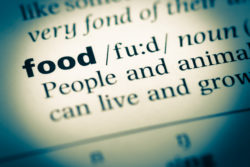 For almost 30 years, I have used Sharon Tyler Herbst’s “Food Lover’s Companion: Comprehensive Definitions of Over 3,000 Food, Wine and Culinary Terms” as my go-to guide for food descriptions. From haggis to winged beans, this book has it all. But what happens when the information landscape changes and more of our culinary language becomes part of the vernacular for the general public? What resource do you reach for once it hits the mainstream?
For almost 30 years, I have used Sharon Tyler Herbst’s “Food Lover’s Companion: Comprehensive Definitions of Over 3,000 Food, Wine and Culinary Terms” as my go-to guide for food descriptions. From haggis to winged beans, this book has it all. But what happens when the information landscape changes and more of our culinary language becomes part of the vernacular for the general public? What resource do you reach for once it hits the mainstream?
If you guessed the Merriam-Webster Dictionary, you are correct! Merriam-Webster.com recently released a list of 850 words – many of them devoted to food-related terms, including a sizable portion associated with international cuisine. According to Emily Brewster, associate editor at Merriam-Webster, for a word to be added to the dictionary, it must have “widespread sustained and meaningful use.”
To me, this demonstrates just how much our collective food intelligence is expanding. Have you noticed how our food options are getting increasingly diverse and more interesting in our home towns?
USA TODAY picked up this story, referencing many of the words that were devoted to food, as well. Here’s a sentence I came up with to highlight some of them:
While I was at the park, I ate my natto over steamed rice and kabocha, which was seasoned with harissa. Afterward, I washed it all down with some kombucha.
Huh?
If these words sound foreign to you, then you’re right! These are terms for a variety of international foods that are becoming popular enough in the United States to be added to the dictionary.
So what was I enjoying in the park?
I was eating a pungent and gluey dish of fermented beans over steamed rice and a variety of Japanese squash seasoned with a spicy blend of North Africa Chilies. I then had a yummy, slightly tart and gelatinous carbonated yeast beverage.
Other new terms include aquafaba, which is the flavorful liquid you are left with after cooking beans. In the South, we call this “pot liquor,” and it’s a food group all its own to us. The juice from canned chickpeas (garbanzo beans) is very popular in vegan, vegetarian and restricted diets. It is also structurally complex enough to use as an egg substitute in waffles and pancakes and can be substituted for egg whites in meringue.
The term fond (fahn) might sound familiar to those who have attended a braising pan training class hosted by Chef Steve or myself. Fond is the essence of a dish. It is found in the juicy bits of brown goodness that remain in the bottom of the pan after sautéing or roasting. When the pan is deglazed, the flavor explodes in the resulting sauce or gravy giving it a deep, rich flavor and color. It makes what would otherwise be a bland dish, beautiful.
If you burn the fond due to uneven heating or wild temperature swings, you might as well start over. However, this isn’t a problem most people have when they use a Groen braising pan. It’s superior temperature management allows for industry-leading evenness across the cooking surface. When combined with Groen’s new electronic controller, it provides a consistent temperature setting that sets the Groen braising pan far ahead of the pack.
Some more recognizable terms included poke, queso, unoaked, tzatziki and a golfer’s favorite, the Arnold Palmer.
As you can see, the dictionary has become another good resource for expanding your food horizon. Likewise, if you want to learn more about Groen braising pans, visit www.unifiedbrands.net.
Enjoy the food!
Michael Williams